Visiting Olympic in Autumn Overview
Learn About Visiting Olympic National Park in Autumn
Autumn comes with a punch in Olympic National Park. Snow dusts the mountaintops starting, most years, in October. Thus at lower elevations, it is the start of the rainy season; the park can receive up to 12 feet of precipitation annually. Although you may not expect it at first, the forest is one of the best places to be in the rainy autumn. The thick canopy of deciduous and coniferous trees, draped with mosses and ferns, creates a nice cover as you’re walking in the rain. And, as these deciduous change into yellows, oranges, and reds, they pop extraordinarily against the greens of the rainforest. There are many benefits of visiting Olympic National Park in the autumn, as well as a couple of drawbacks. Below, we will go into detail about what to expect when visiting the park in the autumn.
BENEFITS OF VISITING IN AUTUMN
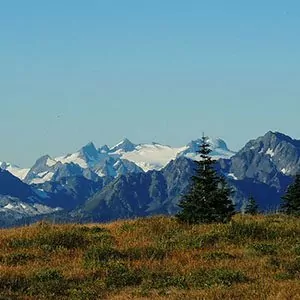
As mentioned above, the changing colors of leaves in the rainforest is one of the best things about visiting Olympic National Park in the autumn. Although the Queets, Quinault and Hoh Rainforests are primarily dominated by coniferous trees, including Sitka spruce, Western hemlock and Douglas fir, there is also an abundance of deciduous trees whose leaves change into vibrant colors when autumn arrives. These exuberant yellows, oranges and reds pop against the lush greens of the rainforest. And, even with the rain, hiking can still be enjoyable in autumn because the dense canopy creates a shade over the trail.
Another benefit of visiting Olympic National Park in the autumn is the moody coast. The pristine coast becomes empty and secluded in the autumn, and is a perfect place to watch a storm roll in. Scattered driftwood, waves crashing against rugged rocks, storm clouds setting a dramatic mood—everything about the coastline in the autumn is classic Pacific Northwest, and something you do not want to miss.Last, but definitely not least, one of the best things about visiting in autumn is the lack of crowds. Olympic National Park is the 7th most visited National Park, but three-quarters of annual visitation occurs from June to early September; leaving the rest of September through November quite barren, and perfect for exploring without congestion. You will be able to find seclusion and tranquility along most trails in the park without trying too hard, making this a wonderful time of year to be in Olympic National Park.
DRAWBACKS OF VISITING IN AUTUMN
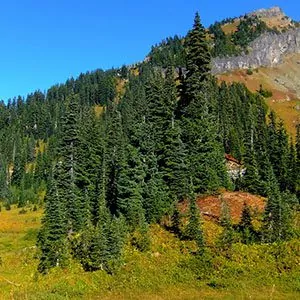
The biggest drawback to visiting in autumn is the start of the rainy season. Some days, it can pour up to 6 inches of rainfall. However, there are so many ways to enjoy the park when it is raining—just don’t forget your rain jacket! The weather is a little unpredictable, but as long as you are prepared, you can experience the dramatic weather patterns in the mountains, rainforest and at the coast.
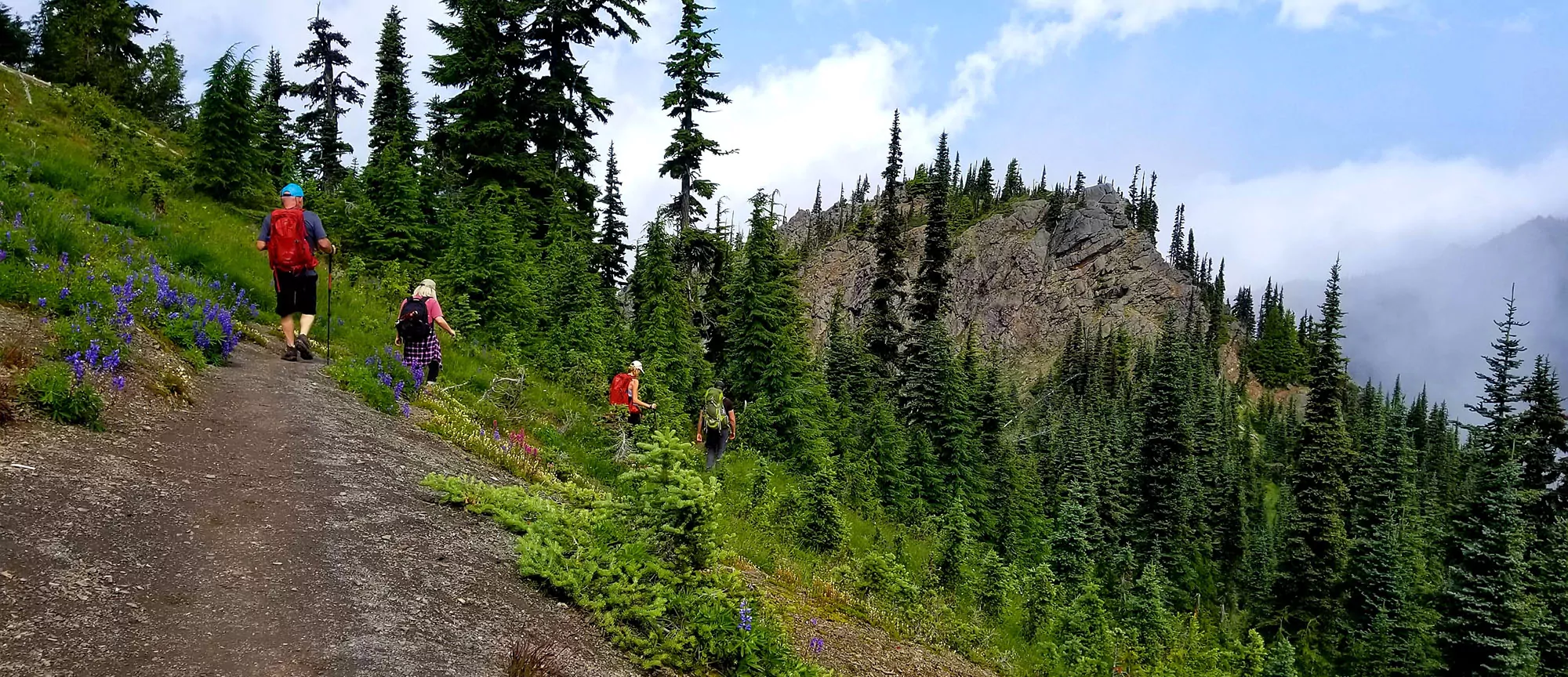
CLIMATE AND TEMPERATURE IN AUTUMN
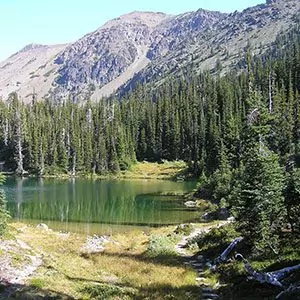
The reason that Olympic National Park sees so much annual rainfall is because of the “Rain Shadow Effect”: When a storm rolls onto land from the Pacific Coast, it reaches a huge obstacle at the Olympic Range. If clouds are like giant sponges, saturated with moisture, they need to rise to get over the mountain range, and with all that moisture, they are just too heavy. So, they wring out the water in the form of rain, making themselves lighter and easier to cross over the range. By the time the storm reaches the other side of the Olympic Range, it has lost a lot of its moisture, and because of this, the west side of the park is much wetter than the east side (and why the Queets, Quinault and Hoh Rainforests are all on the west side of the mountains).
In autumn, the Peninsula experiences more storms rolling in from the ocean, so there is a rise in precipitation. But, depending on where you want to spend your time while in the park, the amount of rain may be variable. Because the weather is unpredictable, make sure you look at the forecast throughout your trip. You can check the current weather for Hurricane Ridge, the Quinault Rainforest, and Rialto Beach. Below are the average temperatures and days of precipitation in autumn for the three locations:
| Month | Hurricane Ridge | Quinault Rainforest | Rialto Beach | Days of Precip | |||
| Avg Hi | Avg Lo | Avg Hi | Avg Lo | Avg Hi | Avg Lo | ||
| September | 51°F (10°C) | 35°F (1°C) | 69°F (20°C) | 49°F (9°C) | 66°F (18°C) | 49°F (9°C) | 8 Days |
| October | 41°F (5°C) | 29°F (-2°C) | 59°F (15°C) | 44°F (6°C) | 57°F (14°C) | 43°F (6°C) | 14 Days |
| November | 32°F (0°C) | 23°F (-5°C) | 49°F (9°C) | 39°F (3°C) | 50°F (10°C) | 38°F (3°C) | 20 Days |
THINGS TO DO IN AUTUMN
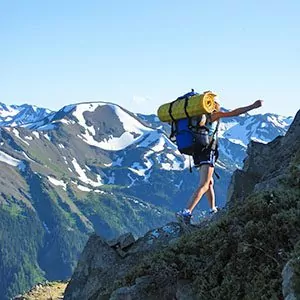
When deciding when to visit the park, you should take the activities you want to do into consideration. No matter what interests you, there is so much you can do to explore the park. Below are the most popular things to do in Olympic National Park in autumn:
Hiking: Autumn is a magical time of year to go for a hike in Olympic National Park. The rainforests are speckled with vibrant fall colors, the coastline provides excellent opportunities to watch a storm roll in, and getting up high in the mountains gives you incredible views of autumn unfolding throughout the park. Because most of the crowds have left in early September, you will experience solitude and seclusion along most trails. As always, check the trail conditions before hitting the trail.
Backpacking: The cooler temperatures make autumn the perfect time for a backpacking trip in Olympic, just make sure you have rain gear, and having a tarp is helpful to make a rain shelter. Because there are fewer visitors in the park, you have a better chance of obtaining the permits that you want. Just remember that snow begins to cover the mountaintops as early as late September. As you are planning your trip, make sure you take a look at the park’s trail conditions, so you know which campsites you can string together for a multi-day trip.
Wildlife viewing: One of the best things about visiting in autumn is wildlife viewing. Especially, the Roosevelt elk. Their mating season, known as “the rut”, begins in September and lasts most of the season. The rut is characterized by large bull elk parading around, showing off their large rack of antlers, and calling out in their infamous bugle. To get the best elk experience, head to the Hoh Rainforest, this is one of their favorite habitats in the park, and a great place to find elk in the autumn. Other animals you may encounter in the autumn include marmots, birds, and mountain goats. Autumn is also mating season for mountain goats, and while it is interesting to watch the males compete for their group of females (called nannies), they are very aggressive this time of year, so use caution at all times.
Bird watching: Autumn is the best time of year to watch for the Horned lark, American pipit, grebe, cormorant, palm warbler, and loon. Hurricane Ridge is the most popular spot for birders in the autumn, with many gathering early in the morning at the Hurricane Ridge Visitor Center. The Audubon Society is an excellent resource for the native bird populations in the Olympic Peninsula.
Whale watching: Kalaloch Beach is one of the most renowned places in the world to see whales as they travel from their breeding ground in Baja California to the Bering Strait, and back again. The best times of year to watch them past the Olympic’s western coast are April-May and October-November. Port Angeles (about three hours northeast of Kalaloch) offers whale-watching tours, guiding you through the Strait of Juan de Fuca in search of humpback and orca whales, elephant seals, and sea lions.
Fishing: Some of the most popular fishing destinations in Olympic National Park in autumn include the Ozette River, Elwha River, Queets River, and Hoh River. Ozette River in autumn is perfect because Cutthroat trout swim upstream from where they spawned in the ocean to reside in Ozette Lake. Elwha River is ideal for catching Coho salmon, and Queets and Hoh Rivers are known for Chum salmon and Chinook salmon from September to November. Make sure you read the park’s fishing regulations before heading out.
Storm-watching at the coast: Watch the coast become moody as dramatic storms roll in, creating dark and dense clouds, with angry waves beating against the rugged rocks. This makes for some pretty picture-perfect photo opportunities. Rialto Beach, Hole-in-the-Wall, Second Beach, and Shi Shi Beach are the best places to watch these ravenous and raging storms reach the coast.
Tidepooling: While you are storm-watching at the coast, make sure you look down too! In the tiny pools that gather after the tide recedes, you can find tiny marine organisms crammed into a space the size of a dinner plate—sometimes up to hundreds of these tiny, vibrant, spiky creatures! The best locations for tidepooling are Beach 4 at Kalaloch and Hole-in-the-Wall at Mora.
HIKING IN OLYMPIC IN AUTUMN
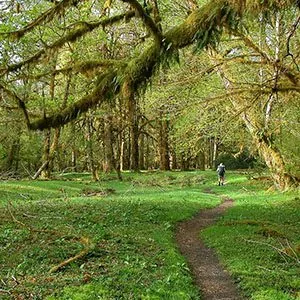
Hiking in Olympic National Park is absolutely world-class in the autumn. With so many trails in Olympic National Park, it may be difficult to decide which ones are best this time of year. Below, we have described our four favorite hikes to do in autumn. These will provide the best opportunity to experience the fall foliage and other magical aspects of autumn in Olympic National Park.
- Trailhead: Staircase Ranger Station
- Distance: 4 miles roundtrip
- Elevation Gain: 150 feet
Hike from Staircase along the North Fork of the Skokomish River, through dense and vibrant rainforest. With thick trees, ferns, and mosses, you will be able to experience the ecology of Olympic National Park’s old-growth forest. The path winds next to the meandering river; dramatic rapids are seen and heard throughout the route, helping you to realize how powerful the Skokomish River is. Around two miles, you will reach an impressive suspension bridge crossing the river, this is a good turn-around point. We recommend doing this as a guided day hike—all gear, lunch, snacks, and a knowledgeable guide are provided by the company. With a local and professional guide leading the way, you will learn all about the ecology and biology of this unique and diverse ecosystem.
2. FIVE MILE ISLAND:
- Trailhead: Hoh River Trail
- Distance: 10.6 miles roundtrip
- Elevation Gain: 300 feet
Hiking through Hoh Rainforest is a magical experience; characterized by gigantic trees, tumbling moss, Roosevelt elk, chirping birds, and the rushing river. In autumn, the maple and cedars that live in this magnificent rainforest change into brilliant reds and oranges, popping against the otherwise dense green foliage. Hiking to Five Mile Island is perfect for all levels of ability since it is easy and flat with little elevation gain. The trail wanders next to the river, and Five Mile Island, at nearly 5.3 miles, is a lovely lunch spot and vantage point to see Bogachiel Peak in the distance. If it is raining, you can continue on to the Happy Four Shelter, which is just .5 miles up the trail.
3. OZETTE TRIANGLE:
- Trailhead: North Sand Point Trail
- Distance: 9.2 miles roundtrip
- Elevation Gain: 100 feet
Soon after starting at Lake Ozette, you will reach boardwalks that lead you through dense Western redcedar, Bigleaf maple, Licorice ferns, and Cat-tail moss. The deciduous trees throughout the old-growth forest stand boldly with their exuberant colors. At 3.3 miles, you will be able to smell the ocean before you can see it, and the trail drops you off at the coast. The best thing about this coastline is how isolated it is; the only thing that seems to have been there lately is the lively marine life. You will pass Wedding Rocks, home to ancient petroglyphs, on your way to Sand Point—which is one of the most pristine and dramatic beaches in the country. Look for a trail marker taking you back into the forest to complete the loop.
4. ROYAL BASIN:
- Trailhead: Upper Dungeness Trailhead
- Distance: 16 miles roundtrip
- Elevation Gain: 2650 feet
Start on the Upper Dungeness Trail until you reach the junction for Royal Basin Trail, just over a mile in. After a series of switchbacks, the meadow opens up with captivating views up and down the valley, surrounded by moss-covered trees and the ground blanketed by magical ferns. The trail consists of long traverses interspersed with steep climbs until you reach Royal Lake at 7.2 miles, the reds and oranges of autumn’s foliage creating a perfect reflection in the crystal-clear water. About ¾ miles further from Royal Lake, you can take in the view of Upper Royal Basin, with its alpine meadows and milky-blue tarns.
BACKPACKING IN OLYMPIC IN AUTUMN
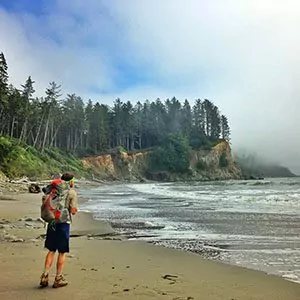
Backpacking is ideal in September, October, and November. Although it may be a little rainy this time of year, with the right gear—rain gear, waterproof boots, lots of socks, layers, etc.—you are sure to have an incredible backpacking trip in Olympic National Park. The crowds have dissipated by October, so finding the permits you desire is simple and easy, and you may have the chance of complete solitude on the trail. Below are our four favorite trails for backpacking in autumn, they are beautiful year-round, but especially in the autumn—full of vibrant colors as the trees transition through the seasons.
1. HOH RIVER TRAIL
- Trailhead: Hoh River Trail
- Distance: 37 miles
- Days to complete: 4-5
Backpacking through the Hoh Rainforest is idyllic in the autumn. The colors are spectacular and all of your senses will be heightened as you hike next to the Hoh River. There are many wilderness campsites along the Hoh River, ranging in distance from 3 miles (Mt. Tom Creek) to 17.4 miles (Blue Glacier at Mount Olympus). The first 10 miles of the trail are relatively flat, gaining only about 350 feet over all 10 miles; but once you reach Olympus Ranger Station, the trail starts to gain serious elevation as it climbs up the side of Mount Olympus.
Let an experienced guide lead you up to Blue Glacier on a Hoh River Traverse guided backpacking trip. With all the appropriate gear and delicious backcountry meals provided, you can rest easy knowing that you are in good hands, as your safety is the company’s main priority.
2. QUINAULT RIVER TRAIL
- Trailhead: Graves Creek Trail
- Distance: 26 miles
- Days to complete: 4
Backpacking along the Quinault River is absolutely enchanting. The relatively flat terrain is perfect for all levels of experience, including families, or first-time backpackers. You will be mesmerized by the clear, blue-green water of Quinault River, the moss-covered trees—straight out of a fairy tale, and the mystery of the old-growth forests. Great backpacking destinations along this route include O’Neill Creek, a 13.2-mile trip, and Enchanted Valley, a 26-mile trip. You can read all about this route on our trail guide, or join a Enchanted Valley guided backpacking trip.
3. ROYAL BASIN
- Trailhead: Upper Dungeness Trailhead
- Distance: 16 miles
- Days to complete: 3
Experience the solitude of autumn on an epic journey through Royal Basin. The colors of fall jump out against the surrounding greenery, and the big views along the trail are awe-inspiring. Start on the Upper Dungeness Trail, and after one mile, turn right at the junction for Royal Creek Trail. There are multiple wilderness camp areas along the route and even one along the banks of Royal Lake. Permits are required and can be obtained at one of the Wilderness Information Centers in the park.
4. ELWHA VALLEY TO LAKE QUINAULT
- Trailhead: Whiskey Bend Trailhead (going north to south) or North Fork Trailhead (going south to north)
- Distance: 44 miles
- Days to complete: 4-5
Retrace the footsteps of the historic Press Expedition, a 44-mile traverse from Elwha Valley, just south of Port Angeles to the North Fork of the Quinault River, just north of Lake Quinault. In 1889, an expedition, sponsored by the Seattle Press, left Port Angeles in hopes of exploring the wilderness of the Olympic Wilderness. Six months later they arrived at Quinault Lake. Nowadays, it takes backpackers only four to five days to complete the same journey. The route takes you through ancient and mysterious old-growth forests, pristine alpine meadows, and deep river crossings. Let Wildland Trekking take you on a Historic Press Traverse guided backpacking trip, where your local guide will share their knowledge about the historic expedition, in addition to the ecology and history of this diverse landscape.
Join a Guided Hiking Adventure
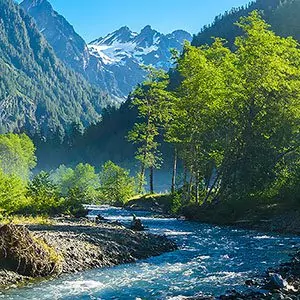
Olympic National Park is home to some of the most epic and amazing hiking vacations in the world. Wildland Trekking offers trips with the best of Olympic: the coast, the mountains, wildlife, solitude, adventure, and fascinating natural and cultural interpretation. Guided Olympic National Park treks are all-inclusive which covers permits, local transportation (excluded on certain tours), meals, equipment, safety systems, and professional hiking/wilderness guides; all of which allow visitors to maximize their time in Olympic and focus entirely on enjoying the Park.
OLYMPIC ADVENTURE TOURS
- GUIDED BACKPACKING ADVENTURES: these are for people interested in an authentic Olympic National Park adventure away from the roads and crowds.
- INN-BASED PACKAGES: these tours are all-inclusive packages with lodging, amazing daily hikes, expert guides, meals, transportation, and more!
- CAMPING-BASED HIKING PACKAGES: camping-based hiking packages provide all-around hiking experiences of the Olympic Coast on wonderful outdoor vacations.
- DAY HIKE TOURS: maximize your day in Olympic National Park on a fully guided, award-winning hiking tour on one of the Park’s best trails.






